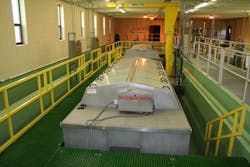The Oconomowoc (Wisc.) Wastewater Treatment Facility (WWTF) needed to repair or replace its existing shallow-bed traveling bridge sand filters. The sand filters had reached the end of their lifespan and needed significant maintenance improvements to continue to be viable. In addition, the facility needed to upgrade its filtration capacity from 9 mgd to 12 mgd in order to allow treatment of peak capacities. The City of Oconomowoc worked with engineering firm Ruekert/Mielke to evaluate various technologies to replace the existing filters.
Solution
Together with Ruekert/Mielke, the city determined that Veolia’s Hydrotech Discfilter system would be a suitable replacement for the existing filters. Four of the model HSF2214-1F Discfilter units with an integrated programmable logic controller (PLC) system would be provided by Veolia. The system would be designed to meet ten state standards by maintaining loading rates of less than or equal to 5 gpm/sq ft during peak flow conditions with one of the units out of service. It would provide a significant project cost savings compared to conventional treatment alternatives. As a result of the compact footprint and low operating head loss of the Hydrotech units, the filters could be located within the existing filter basins while providing the increased capacity to allow treatment of up to 12 mgd. In addition, the city anticipated reductions in operation and maintenance costs as a result of the lower backwash volumes and reduced equipment repair costs associated with the Veolia system.
The city installed the Discfilter system with a phased approach. First, it removed half of the existing sand filters from service in order to clean out those filter cells and install two of the Discfilters. The first two Discfilters were installed in one side of the existing filter building and were commissioned in November 2008. After these units were online, the city decommissioned the rest of the existing filters, and the basins were prepared for the remaining Hydrotech Discfilters. The project was completed in March 2009 when the final two Discfilters were commissioned.
Results
The facility has consistently met permit limits since completing the filter project. The influent to the filter system typically averages approximately 10 to 15 mg/L of total suspended solids (TSS), with peaks up to 35 to 40 mg/L, while the Hydrotech Discfilter system produces effluent with average TSS of less than 3 mg/L. While the sand filters typically averaged approximately 60% removal of TSS, data collected by the facility after Discfilter startup has demonstrated the system’s ability to routinely achieve 80% to 90% removal of TSS. Additionally, the backwash volumes have been reduced significantly and filtration system maintenance has dropped to a minimum.
The straightforward and user-friendly design allows routine inspection and maintenance to be performed with ease. Another benefit of the system is the added flexibility that having four units provides compared to only two units with the previous sand filters. This allows the facility to maintain, inspect and repair the filter equipment without such a large reduction in capacity when one unit is removed from service.
The operations manager for the WWTF, Tom Steinbach, has seen another benefit that was not anticipated.
“The old filters had a large water surface area that was exposed inside the filter building, resulting in high humidity,” he said. “The enclosed Discfilter design has removed the exposed water surface area and dramatically reduced the humidity in the building, resulting in an unexpected reduction in our energy cost for heating. This is just another example of how the Discfilters are helping us save money at the plant.”
The project to install Veolia's Hydrotech Discfilter system is enabling the facility to easily meet its stringent effluent limits, increase filtration capacity and reduce cost while maintaining the existing facility footprint and hydraulic profile.



